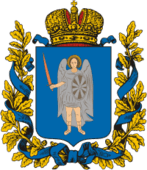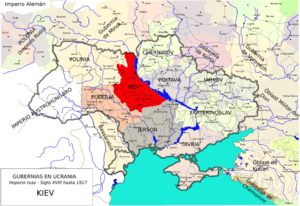Kiev Governorate
Coordinates: 50°27′00″N 30°31′25″E / 50.4500°N 30.5236°E
| Kiev Governorate Кіевская губернія | |||||
| Governorate of Russian Empire, Ukraine | |||||
| |||||
 | |||||
 | |||||
| Capital | Kiev | ||||
| History | |||||
| • | Established | November 30, 1796 | |||
| • | Disestablished | 1923 | |||
| Political subdivisions | uyezds: 12 | ||||
| Today part of | |||||

Kiev Governorate was an administrative division of the Russian Empire and Ukraine in 1796 until the Soviet administrative reform of the 1920s. It was considered to be a Little Russian (Ukrainian) governorate due to majority of population speaking in Little Russian dialect (Ukrainian language).
History
The Kiev Governorate on the right bank of Dnieper was officially established by Emperor Paul I's edict of November 30, 1796. However it was not until 1800 when there was appointed the first governor and the territory was governed by the Kiev Viceroy Vasiliy Krasno-Milashevich (in 1796-1800).
Three existing Left-bank Ukraine viceroyalties were merged into one Little Russia Governorate centered on Chernigov, while the Kiev Governorate was now comprised on Right-bank Ukraine. With Kiev still a capital, the governorate included the right-bank parts of the former Kiev Viceroyalty merged with territories of the former Kiev[1] and Bracław Voivodeships which were gained by the Russian Empire from the partitions of the Polish-Lithuanian Commonwealth (the lands of the Polish Crown province).[2] The edict took effect on August 29, 1797, bringing the total number of uyezds to twelve.[2]
On January 22, 1832, the Kiev Governorate, along with the Volhynia and the Podolia Governorates formed the Kiev Governorate General, also known as the Southwestern Krai.[3] At the time, Vasily Levashov was appointed the Military Governor of Kiev as well as the General Governor of Podolia and Volhynia. In 1845, the population of the Governorate was 1,704,661.[2]
At the turn of the 20th century, the governorate included twelve uyezds named by their centers: Berdychiv, Cherkasy, Chyhyryn, Kaniv, Kiev, Lipovets, Radomyshl, Skvyra, Tarashcha, Uman, Vasylkiv and Zvenyhorodka.[4]
By the 1897 Russian Census, there were 3,559,229 people in the guberniya making it the most populous one in the whole Russian Empire.[4] Most of population was rural. There were 459,253 people living in cities, including about 248,000 in Kiev. According to the mother tongue, the census classified the respondents as follows: 2,819,145 Little Russians (the Russian government term for Ukrainians) representing 79.2% of the population, 430,489 Jews representing 12.1% of the population, 209,427 Great Russians (the Russian government's term for Russians) representing 5.9% of the population, and 68,791 Poles representing 1.9% of the population.[5] By faith, 2,983,736 census respondents were Orthodox Christians, 433,728 were Jews and 106,733 were of the Roman Catholic Church.[4][6]
Kiev Governorate remained a constituent unit of the larger Governorate General with Kiev being the capital of both well into the 20th century. In 1915, the General Governorate was disbanded while the guberniya continued to exist.
Principal cities
Russian Empire Census of 1897[7]
- Kiev – 247,723 (Russian - 134 278, Ukrainian – 55 064, Jewish – 29 937, Polish - 16 579, German - 4 354, Belorusian - 2 797)
- Berdichev – 53,351 (Jewish – 41 125, Russian – 4 612, Ukrainian – 4 395)
- Uman – 31,016 (Jewish – 17 709, Ukrainian – 9 509, Russian – 2 704)
- Cherkassy – 29,600 (Ukrainian – 12 900, Jewish – 10 916, Russian – 4 911)
- Skvira – 17,958 (Jewish – 8 905, Ukrainian – 7 681, Russian – 956)
- Zvenigorodka – 16,923 (Ukrainian – 8 337, Jewish – 6 368, Russian – 1 513)
- Vasilkov – 13,132 (Ukrainian – 7 108, Jewish – 5 140, Russian – 820)
- Tarascha – 11,259 (Ukrainian – 5 601, Jewish – 4 906, Russian – 575)
- Radomysl – 10,906 (Jewish – 7 468, Ukrainian – 2 463, Russian – 778)
- Smaller cities
After 1917
In the times after the Russian revolution in 1917–1921, the lands of Kiev Governorate switched hands many times. After the last Imperial governor, Alexey Ignatyev until March 6, 1917, the local leaders were appointed by competing authorities. At times, the Governorate Starosta (appointed by the Central Rada) and the Governorate Commissar (sometimes underground) both claimed the Governorate, while some of the short-lived ruling regimes of the territory did not establish any particular administrative subdivision.[8]
As chaos gave way to stability in the early 1920s, the Soviet Ukrainian authority re-established the Governorate whose leading post was titled the Chairman of the Governorate's Revolutionary Committee (revkom) or of the Executive Committee (ispolkom).[8]
In the course of the Soviet administrative reform of 1923–1929 the Kiev Governorate of Ukrainian SSR was transformed into six okruhas in 1923, and, since 1932, Kiev Oblast at the territory.[8]
List of okruhas
- Berdychiv Okruha
- Bila Tserkva Okruha
- Kiev Okruha
- Malyn Okruha (1923–24)
- Uman Okruha
- Cherkasy Okruha
- Shevchenko Okruha (1923–25, initially as Korsun)
Governors of Kiev
Russian Empire
- 1839-1852 Ivan Funduklei
- 1852-1855 Andrei Krivtsov (acting)
- 1855-1864 Pavel Gesse
- 1864-1866 Nikolai Kaznakov
- 1866-1868 Nikolai Eiler
- 1868-1871 Mikhail Katakazi
- 1881-1885 Sergei Gudim-Levkovich
- 1885-1898 Lev Tomara
- 1898-1903 Fyodor Trepov
- 1903-1905 Pavel Savvich
- 1905-1905 Aleksandr Vatatsi
- 1905-1906 Pavel Savvich
- 1906-1906 Aleksei Veretennikov
- 1906-1907 Pavel Kurlov (acting)
- 1907-1909 Pavel Ignatiev
- 1909-1912 Aleksei Girs
- 1912-1915 Nikolai Sukovkin
- 1915-1917 Aleksei Ignatiev
Russian Republic
as Governing Commissioners
- 1917-1917 Mikhail Sukovkin
- 1917-1918 Oleksandr Salikovsky
Ukrainian State
as Governing Elders
- 1918-1918 I.Chartoryzhski
South Russia
- 1919-1919 Andrei Cherniavsky
Soviet governors
- 1919-1919 Yakov Yakovlev
- 1919-1920 Abram Glinski
- 1920-1920 Ivan Klimenko
- 1920-1920 Panas Lyubchenko
- 1920-1920 Yan Gamarnik
- 1920-1921 Aleksandr Odintsov
- 1921-1921 Nikolai Golubenko
- 1921-1923 Lavrentiy Kartvelishvili
- 1923-1923 Vladimir Loginov
- 1923-1924 Juozas Vareikis
- 1924-1924 Lavrentiy Kartvelishvili
- 1924-1925 Pavel Postyshev
Maps
 Kiev Governorate as of 1896.
Kiev Governorate as of 1896. Kiev Governorate as of c. 1900
Kiev Governorate as of c. 1900
See also
Footnotes and references
| Wikimedia Commons has media related to Kiev Governorate. |
- ↑ Despite the loss of Kiev almost three centuries earlier, Poland still designated an administrative unit centered in Zhitomir as the Kiev Voivodship
- 1 2 3 Иван Фундуклей. "Статистическое описание Киевской Губернии", Часть I. Санкт-Петербург, 1852. (Ivan Fundukley. Statistical Description of Kiev Governorate. St. Petersburg, 1852)
- ↑ Киевское, Подольское и волынское генерал-губернаторство (Юго-Западный край) 22.01.1832–1915
- 1 2 3 Киевская губерния and Киевская губерния (дополнение к статье) in Brockhaus and Efron Encyclopedic Dictionary
- ↑ The First General Census of the Russian Empire of 1897. Breakdown of population by mother tongue and districts* in 50 Governorates of the European Russia Demoscope Weekly, Institute of Demography at the National Research University "Higher School of Economics." The Russian census grouped "Little Russians" (Ukrainians), "Great Russians" (Russians) and Belarusians together for an all-"Russian" total of 3,034,961
- ↑ The 1897 Russian Census classified the population by the responses to the questions on religion and mother tongue. See, e.g. Маргарита Григорянц, "Первый демографический автопортрет России", Мир России, 1997, Т. VI, № 4, С. 45–48
- ↑ Breakdown of population by mother tongue and districts in 50 Governorates of the European Russia at Demoscope Weekly, project by National Research University – Higher School of Economics
- 1 2 3 Киевская область
Further reading
- William Henry Beable (1919), "Governments or Provinces of the Former Russian Empire: Kiev", Russian Gazetteer and Guide, London: Russian Outlook – via Open Library
External links
- Shcherbina, V. Kiev voivodes, governors, and general governors from 1654 to 1775 (Кіевскіе воеводы, губернаторы и генералъ-губернаторы отъ 1654 по 1775 г.). "Chtenia v istoricheskom obshchestve Nestora Letopistsa". Kiev 1892.